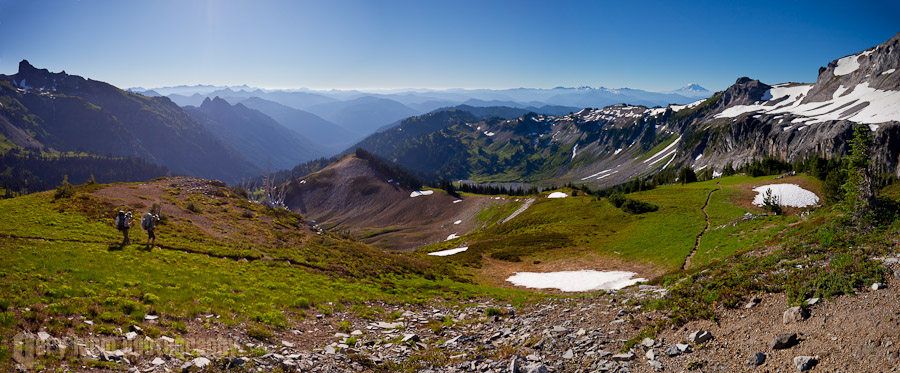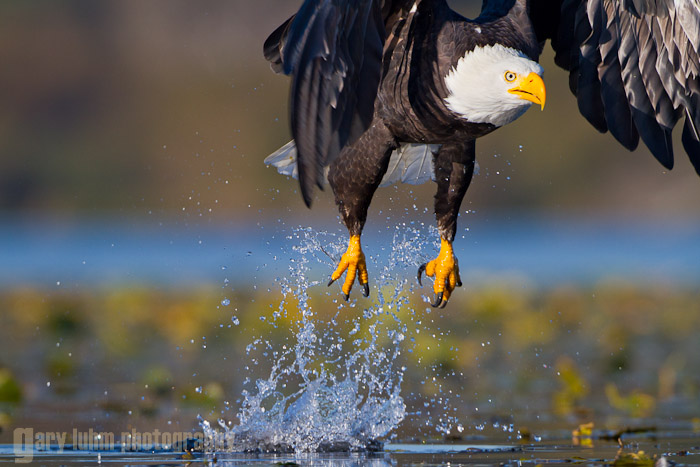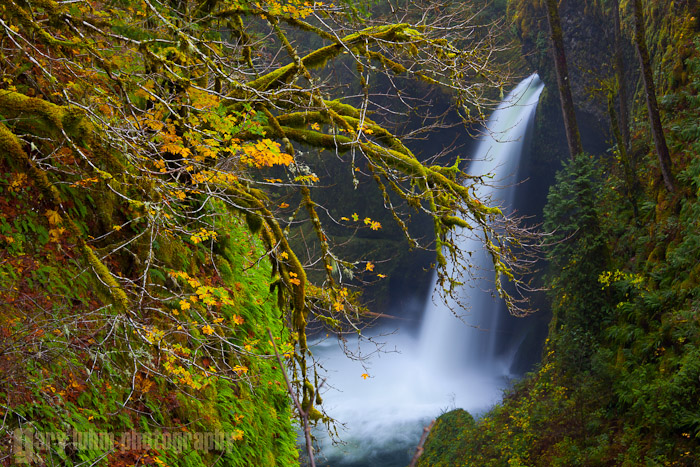Five more favorite images from 2010. It bares repeating: keep that viewfinder glued to your eyeball and look, look, look . . .

Mazama Ridge after Sunset: 2010 wasn’t a good year for Northwest wildflower photography. The mountain meadow flowers were late; many never made it. I made numerous visits to Mt. Rainier, but I never saw a truly showy field. So there I was one post-sunset evening, returning late to the car from the Van Trump Memorial area above Mazama Ridge near Paradise. The sky was clear, with a bit of red glow on the horizon that caused me to pause. There weren’t any good bunches of flowers to put in the foreground, but a nearly full moon was up, and I decided to use the trail as a leading line in a panorama. I was also, regrettably, in a hurry, so instead of a more complicated set up with the camera mounted vertically, I just leveled the tripod, used my (already-mounted) 120mm-long lens plate to place the lens over its optical center, and rotated through three sets of two exposures each. I say regrettably because a pano composed with vertical images—covering the same field-of-view—would yield a 90+ MP (megapixel) file, good for huge prints. This one is 40 MP, less than twice the size of my 21.8 MP Canon 5D II. Anyway, the images in each set were two stops apart, and I later merged the sky and foreground of each pair in Photoshop Elements 8, and then merged the three derived files with Elements Photomerge Panorama. The final image surpassed my expectations, telling a story of transition, between day and night, between a thin red sunset and the moonlit Tatoosh Range.

Ohanapecosh Park to Indian Bar: At the end of August we did 33 miles of the Wonderland Trail, the east and south side of Mt. Rainier, from White River to Longmire. I’ve seen few photos from here, and I mistakenly hoped for wildflower gardens at Ohanapecosh Park with the Mountain behind. After Summerland, though, the Mountain disappears from view, all the way from Panhandle Gap to past Indian Bar, finally emerging only after the climb out to the Cowlitz Divide. This image is from above Ohanapecosh Park, looking away from the Mountain and to the southeast, a couple hours after sunrise. It’s a handheld panorama assembled from three horizontal images. I like the high alpine desolation, the backlit Cascades, the distant Goat Rocks and Mt. Adams, and the seldom seen view this image provides. Especially, I like the human scale provided by my two backpacking companions, hiking the Wonderland Trail as it snakes downward toward Indian Bar.

Prusik Peak and Gnome Tarn: My friend Rich Byrne got lucky and scored Enchantment permits for October 6-10, golden larch prime time, so we had those dates locked in back in March. Backpacking the Enchantments means getting in shape, and it seemed the whole summer was preparation, doing vigorous day hikes, slogging up local hills with a 30-lb pack for training, and doing backpacks of increasing difficulty. When the date arrived, we entered over Aasgard Pass in good weather, and set up a base camp near Perfection Lake. Then we had a day-and-a-half of overcast, poor light for photographing larches. The sun returned briefly on the afternoon of day three. I hiked to the iconic Prusik-Peak-from-Gnome-Tarn photo op for the evening shot.
Prusik Peak boasts a striking vertical face and a jagged ridgeline. A breeze started blowing across Gnome Tarn shortly after I arrived, disturbing the reflection, but I found that by moving left, the middle-ground rocks served both to block the ripples and add a compositional element, as the evening light warmed. The clouds, which appeared momentarily, provided the bonus that sealed the shot. Two minutes after I made this exposure, we lost the light on the larches. A few minutes after that, the whole peak was lost to the shadows of the Stewart Range peaks.

Bald Eagle Lift off: Lake Washington’s Union Bay has been home for a pair of Bald Eagles for a decade. They nest most years in a fir tree on Broadmoor Golf Course. In fall and in winter, they’re often roosting aside the 520 bridge or in cottonwood trees near the UW stadium. A favorite dinner spot seems to be at a log near the bridge, something I’ve discovered while kayaking. On this day the female (judging by the size of her huge talons), was eating fish on the log. I maneuvered my kayak up sun, and with my Canon 7D and 500mm lens, I snapped a few frames. When she finished eating, she walked out to where the log was submerged, and cleaned her bill. At that point she was ready to fly, and I realized I was in a bit close for a lift off, but I couldn’t risk lifting a paddle to retreat for fear of missing the shot; I was in pretty tight. When she abruptly took off, I pressed the shutter before tracking with the camera, which put the bird off-center, and chopped off some of the wings. I was lucky the eye is reasonably sharp, but even though I was close, I was still a good distance away owing to the bigness of the bird, improving my depth-of-field. Too, the shot was at f/5.6, so the background is a pleasing blur. Something else I like: I didn’t have to go to Haines or Homer to get it.

Metlako Falls at Eagle Creek: At the end of October, it’s peak time for fall color in the Columbia Gorge, Oregon. So after a creek-filling storm blew through, we headed south for the Gorge and the Eagle Creek trailhead. It’s a mile-and-a-half hike to Metlako Falls, one of the most photographed of the Gorge’s spectacular waterfalls. The storm had hammered the leaves off the maples, and I was disappointed on seeing them missing from the canyon walls. Therein, however, was opportunity. We arrived at Metlako, and I took some standard, pre-visualize, vertical shots; they were ho-hum without the fall color splendor. So I looked around for alternates, and I saw this shot through the moss-covered, spiderlike, bare branches. A 1.3 sec exposure at f/16 sharpened the image, and rendered the waterfall smooth like silk. I love that spidery maple, the every line pointing or leaning to center, the moss on the branches, the remnant yellow leaves. The image is so self-contained.
Back to 2010 Favorite Images Critique . . .
Gary